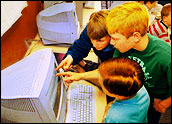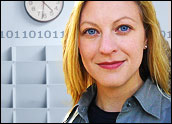
At last week’s UCLA Technology & Aging Conference, representatives from Intel, Microsoft, Qualcomm, Toyota and other big-name firms discussed how technology is reshaping lifestyles for older individuals. However, important policy implications directly connected to these new tools went unspoken.
RFID (radio frequency identification) tags that can monitor the status of older individuals, face-recognition video systems that allow two-way video calls when someone simply enters the room, and robot-assisted remote telesurgery are just a few of the amazing systems described at the conference.
Eric Dishman, Intel’s director of product research and innovation, discussed his company’s goal of getting “rid of the nursing home” and putting “technologies in people’s homes.” Dishman is working from a distributed computing point of view, where caregiver expertise can arrive across time, and medical technology can be distributed from outdated institutions to an individual’s most frequented location.
A More Personalized Health Monitoring System
Technology like RFID tags connected with wireless networks can help create an “always on” health monitoring system, thereby transitioning society away from a “mainframe” medical model and redirecting it toward a smaller, more personalized, PC-type model. This is a great idea, yet the unspoken truth is that this type of communication requires healthy, innovative networks. That raises a key question about Net neutrality, an issue spun and respun by many.
Essentially, it involves a fight over whether network operators, such as Verizon or Comcast, are allowed to continue to set the price for their services and prioritize information that rides on their pipes.
History shows that government regulatory and price controls have a negative effect on innovation, and applying them to the Internet — as Net neutrality advocates want to do — would be disastrous for rolling out newer, faster and more efficient network services. This makes one wonder if Intel’s research and innovation department ever talks with its lobbying arm, because in 2006 the company foolishly jumped on the Net neutrality bandwagon.
Life-Changing Surgery
Video-conferencing technology to increase the social interaction of older people provides another example where Net neutrality rules could harm the “distributed” model for “aging in place.” Imagine walking into your dining room and automatically having the big screen pull up your aging mother at her dining table 3,000 miles away so that you can have dinner together. Social networks are proven to help older people live better and longer, so there should be a good deal of demand for this technology. However, mom may be out of luck.
If the government forces video images to compete for bandwidth on a “neutral basis” with the downloading of hip-hop music in university dorms, then things break down and the system won’t work properly. An even worse scenario could occur given the possibility of robotic surgery.
In 2001, professor Jacques Marescaux, M.D. and his team performed the first clinical robot-assisted remote telepresence surgery, operating on the gallbladder of a patient in Strasbourg, France — 4,000 miles away from their location in New York. What this type of procedure means to remote patients is life-changing, yet such an operation requires a stable and well-managed network, free from the binding hands of politics. Even if the doctors are using a dedicated network, it is still affected by whatever rules bureaucrats place on network operators as a whole.
Analyzing Proposed Legislation
All too often, the Net neutrality debate is spun as if it is synonymous with a free, open and democratic world. However, does it really make sense to tie the hands of network operators and force them to treat music downloads with the same urgency as health monitoring or enhancing technologies? It simply doesn’t, which makes proposals like the Internet Freedom and Nondiscrimination Act, recently reintroduced in Congress, a bad idea.
That act would prohibit network operators from blocking, impairing or discriminating against lawful Internet content, applications and services or charging extra fees for prioritization or enhanced quality of service. Baby boomers, in particular, should be outraged by this type of proposed legislation. They are the generation that fought for civil rights and free speech, and are now witnessing that vision being used as a justification to establish price controls that could mean the difference between life and death for individuals like themselves.
In all, the UCLA Technology & Aging Conference served as a fascinating foray into the future of healthcare, assuming a healthy Internet. Aging and technology is a “broad area that includes people from diverse backgrounds, including industry, academics, healthcare and others,” commented UCLA professor Gary Small, M.D., who organized the conference. Right now, the list does not automatically include regulators at the Federal Communications Commission, and one hopes it will stay that way.
Sonia Arrison, a TechNewsWorld columnist, is senior fellow in technology studies at the California-based Pacific Research Institute.






















































It requires that the content be *monitored*. In other words, Big Brother must watch you. How about we focus on having enough bandwidth for everyone?